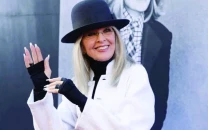Topi ke peechay kia hay?
Santa hat or Jinnah cap — which one will you be adorning this winter?

When it comes to the subject of hats, couture hat designer Louis Green says its best: “wearing a hat is like having a baby or a puppy; everyone stops to coo and talk about it.” This may very well be the reason that every winter, fashion gods go absolutely gaga over the proverbial hat. From mysterious fedoras to alluring hand-knitted French berets — almost everything goes this winter. Except maybe, the ridiculous meat hat adorned by Lady Gaga or the banana and apple-studded fruit hat worn by Carmen Miranda. But when it comes to the streets of Karachi, this must-have fashion accessory marks the line between the young and the old.
The patriotic panama — Jinnah cap
Who would believe that a long time ago, the Jinnah cap was as important to patriots as the ideology of Pakistan? Today, however, the cap seems to be a miss with the Pakistani youth and its sale is largely depended on the elderly. This, we found, while exploring a bustling corner of Karachi’s Saddar district where a small relatively unknown hat store, Rehman Cap, still retails the Jinnah cap. Imtiazur Rehman, the clerk at the store tried to explain the origin of the cap and its fascination. “Made out of lamb wool and purchased from Kabul and Kandahar, the caps were once the talk of town, but now people only wear them occasionally,” says Rehman.
Talking about its significance, Rehman claims, “Worn by the Father of the Nation, this cap broke away from the old, traditional styled Turkish Fez hat. Now there are a few versions to the traditional Jinnah cap — with a shorter version called the Jinnah-Liaquat cap as well as the Jinnah-Ayub cap and Jinnah-Karachi cap.”
With prices ranging from Rs5,00 going all way up to Rs10,000
depending on the quality of wool, its primary target market remain the Muslim customers from Pakistan, India, the US and the UK. One of the store’s loyal customers and Jinnah cap enthusiast Mohammad Akhtar Khan talks fondly about the accessory, “I was barely seven years old when I first visited this shop in 1965. My father used to bring me here. He and my elder brother used to wear the Jinnah cap.”
Today, he was accompanied by his two 20-something sons who have a different opinion on the traditional hat. Khan says, “I still believe it is fashionable, however, the younger lot disagrees.” Khan’s, youngest son Noman Khan confirms this trend, “It gives a very traditional look and it doesn’t go with my persona, but when I’m older I may follow my father’s footsteps.”
The merriment bonnet — the Santa hat
From traffic jams at Khadda Market to the cramped streets of Zamzama, one unusual winter accessory has taken the conventional Karachi public by storm — the Santa hat. As a Muslim-majority nation, its popularity comes as a definite surprise. Sold by street vendors at busy signals, who come from far-off areas of Korangi and Banaras, the hats are priced from Rs150 all the way to Rs600.
With their rising popularity, one would assume that the boys selling these hats would be acquainted with its significance. However, street vendor Farman Khan had no clue of the occasion associated with the cap. “I don’t know why these caps become a hit in the winter season. Even last year, I sold a few but this year, there is even more demand.” The target audience for Santa hats are children as well as the Christian community. Their origins can be traced back to London from where the caps are originally shipped.
Published in The Express Tribune, December 25th, 2011.



















COMMENTS
Comments are moderated and generally will be posted if they are on-topic and not abusive.
For more information, please see our Comments FAQ